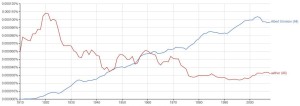Science Seen Physicist and Time One author Colin Gillespie helps you understand your world.
Get a Little Ether in Your Life
In your spaceship, far from any star, can you tell if you are moving? Do you even know what moving means? Physicists thought about this long before we made our way into near-Earth space. And they tangled it up with a concept called the æther.
 The word aether was once widely understood. Winston Churchill uses it in his history The Second World War that clinched the 1953 Nobel Prize for Literature. He spells it the old way, æther, using the Old English letter ash. Æther means the stuff that fills up space so it’s not empty. And it provides an absolute frame of reference for measuring motion (or lack of it) through space. Or so it was once said. But (unknown to Churchill, it seems) around 1905 space was evacuated leaving nothing but confusion. Let’s sort it out, and see how this affects us.
The word aether was once widely understood. Winston Churchill uses it in his history The Second World War that clinched the 1953 Nobel Prize for Literature. He spells it the old way, æther, using the Old English letter ash. Æther means the stuff that fills up space so it’s not empty. And it provides an absolute frame of reference for measuring motion (or lack of it) through space. Or so it was once said. But (unknown to Churchill, it seems) around 1905 space was evacuated leaving nothing but confusion. Let’s sort it out, and see how this affects us.
The story of the æther idea goes like this. In the 1500s people thought that æther carried gravity, but later that idea died out. By the 1800s physicists thought æther carried light like water carries waves, then that died too. By 1950 Polish physicist Leopold Infeld can claim that his colleague Albert Einstein put the last nail in its coffin with special relativity:
We can describe Einstein’s achievement as destroying once and for all the concept of ether ….
Is Infeld right? Well maybe indirectly: Many, like Infeld, claim that Einstein showed there is no ether. This fact is taught to physics students to this day. Though the fact is wrong, sheer repetition of it may have done the æther in. (And, though this could be coincidental, note that Google’s Ngram Viewer shows fewer books mentioning the æther as the number that mention Albert Einstein climb.) But what Einstein actually says in 1905 is that there is no need for an ether that provides an absolute frame of reference at rest. Though he’s famous for changing his mind, as late as 1952 he says much the same:
Since the special theory of relativity revealed the physical equivalence of all inertial systems, it proved the untenability of the hypothesis of an ether at rest.
But Einstein’s full view of the ether (however spelled) was set forth in a lecture on that very subject at the University of Leiden in 1920:
The special theory of relativity does not compel us to deny ether. We may assume the existence of an ether; only we must give up ascribing a definite state of motion to it. … The general theory of relativity … has, I think, finally disposed of the view that space is physically empty.
In other words, Einstein says the ether’s real, but not quite what people imagined. He breathes new life into that idea from the 1500s, calling it the ‘gravitational ether’. This is, he says, another name for space. When you’re adrift in your spaceship space itself may not give you a special frame of reference at rest. But what’s in it―matter and radiation―does.
Infeld’s not alone in ignoring what Einstein really said. Teaching relativity, physics educators may say that You Really Can’t Tell That You’re Moving. Problem is, it’s well established that you really can! For example, recent observations show a red-blue imbalance of the cosmic microwave background (CMB) radiation when the detector is moving. The CMB picture of the universe early in the Big Bang looks bluer in the direction of motion. So when your spaceship is at rest in the universe you see the colour is the same in all directions.
This explanation may make the absolute frame of rest sound like a recent revelation. It’s not. It has been embedded in the math of fundamental physics for almost a hundred years.
Does the idea of absolute rest affect details of your daily life? Not likely. But does it affect how we think about our situation? Absolutely.
Coming soon: Modern cosmology hinges on the universe’s absolute frame of rest.
Sources:
Leopold Infeld (1950), Albert Einstein: His Work and Its Influence on Our World, New York: Charles Scribner’s Sons, p. 24; https://www.questia.com/library/1606210/albert-einstein-his-work-and-its-influence-on-our
Albert Einstein (1916), Relativity: The Special and the General Theory, Robert Lawson (transl., 1952), New York: Crown Trade Paperbacks, in new Appendix 5, “Relativity and the Problem of Space”, p. 170; http://www.gutenberg.org/ebooks/5001
Albert Einstein (1920), “Äther und Relativitätstheorie”, lecture at University of Leiden, 5 May, Berlin: Julius Springer, http://www.geist-oder-materie.de/Naturwissenschaften/Physik/Raum___Zeit___Materie/Einsteins_Relativitatstheorie/Schriften_zur_RT/einstein_zum_ather.html; Wilfred Perrett & George Jeffery (transl., 1922), in Sidelights on Relativity, London: Methuen & Co., p. 3; http://www-history.mcs.st-andrews.ac.uk/Extras/Einstein_ether.html
Other Reading:
Colin Gillespie (2013), Time One: Discover How the Universe Began, New York: RosettaBooks, p. 159, http://www.rosettabooks.com/book/time-one/; “The Problem of the Special Frame”, http://www.timeone.ca/chapters/the-problem-of-the-special-frame.pdf
Image credit: Colin Gillespie

No comments yet.